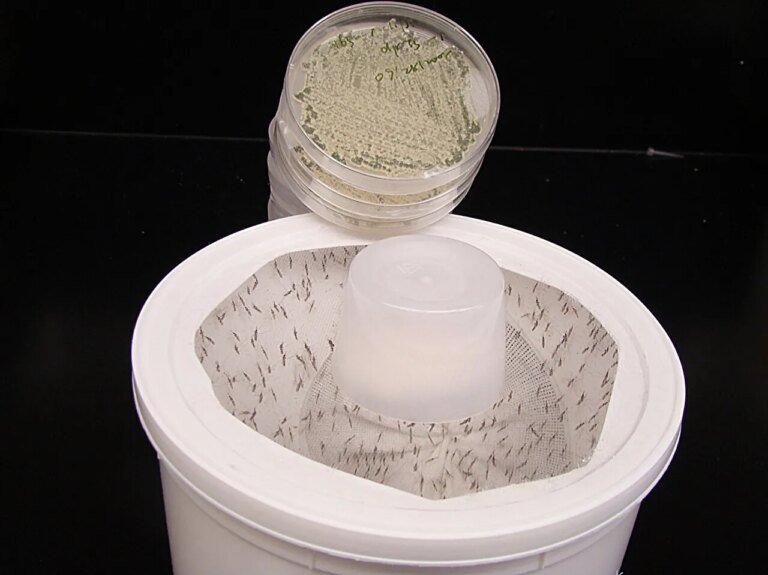Never underestimate the power of fungi. It can turn ants into “zombies,” help fictional plumbers grow, and even look like creepy fingers. One newly engineered strain of fungus uses the power of smell to kill Earth’s deadliest animal—mosquitoes.
Mosquito-borne diseases, including malaria and dengue, kill thousands of people per year. In 2023 alone, malaria killed over 500,000 people in 83 countries. These illnesses are often difficult to control, and mosquitoes have gotten better at resisting chemical pesticides that used to work.
However, fighting nature with nature could be one solution. A fungus called Metarhizium can be used to deactivate mosquito sperm, keeping the deadly ones from spreading disease. It may also help catch and kill the deadly insects.
Since mosquitoes are drawn to flowers, a team of researchers created a new strain of the Metarhizium fungus that imitates a flower’s sweet scent. That natural aroma comes from a chemical called longifolene in many types of flowers. The lab-grown fungus in this study essentially uses the longifolene to lure the bloodsucking mosquitoes to their deaths and is described in a study recently published in the journal Nature Microbiology.
“Mosquitoes need flowers because they provide nectar, a crucial source of food for them, and they are drawn to flowers through their scents,” Raymond St. Leger, a study co-author and entomologist at the University of Maryland, said in a statement.
“After observing that some types of fungi could trick mosquitoes into thinking they were flowers, we realized we could turbo-charge the attraction by engineering fungi to produce more longifolene, a sweet-smelling compound that’s already very common in nature,” St. Leger said. “Before this study, longifolene wasn’t known to attract mosquitoes. We’re letting nature give us a hint to tell us what works against mosquitoes.”
Once the fungus spores are put into a container, the longifolene chemicals are released instantly. They can be effective for months because they also come out gradually and not in one initial burst.

As soon as the mosquitoes encounter the fungus, they become infected and die within a few days. In lab tests, the fungus killed 90 to 100 percent of mosquitoes, even when it was placed in a large room and had to compete with the scents of humans and real flowers. While this fragrant fungus is deadly to mosquitoes, it does not hurt humans. Longiflorine is actually commonly used in perfumes.
“This makes it much safer than many chemical pesticides. We’ve also designed the fungus and its containers to target mosquitoes specifically rather than any other insects and longifolene breaks down naturally in the environment,” said St. Leger.
Using a natural alternative like this fungus may also make it difficult or impossible for mosquitoes to outsmart or avoid, as they have with chemical alternatives.
“If mosquitoes evolve to avoid longifolene, that could mean they’ll stop responding to flowers,” St. Leger explained. “But they need flowers as a food source to survive, so it would be very interesting to see how they could possibly avoid the fungus yet still be attracted to the flowers they need. It’ll be very difficult for them to overcome that hurdle, and we have the option of engineering the fungus to produce additional floral odors if they evolve to specifically avoid longifolene.”
Other forms of Metarhizium are already used around the world to ward off mosquitoes on cheap materials such as chicken droppings, rice husks, and wheat scraps. The affordability and simplicity of the fungus could be key to reducing mosquito disease-related deaths in many parts of the world, particularly in poorer regions in the global south where mosquito-borne diseases are expected to rise due to climate change. The same diseases that are currently limited to tropical regions could also begin to threaten other places due to rising global temperatures.
The team from this study is currently working on larger-scale outdoor trials of the new mosquito control method to submit for regulatory approval.
“It’s not as if you’re going to necessarily find a silver bullet to control mosquitoes everywhere, but we’re trying to develop a very diverse and flexible set of tools that people in different parts of the world can use and choose from,” St. Leger said. “Different people will find different approaches work best for their particular situation and the particular mosquitoes they’re dealing with. In the end, our goal is to give people as many options as possible to save lives.”



